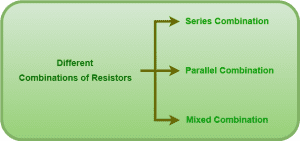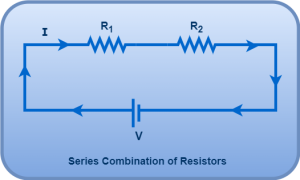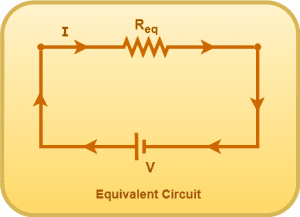Combination of Resistors-
Sometimes, a number of resistors are connected in a circuit in order to get a desired value of current in the circuit.
Resistors may be combined in a circuit in the following ways-

- Series Combination
- Parallel Combination
- Mixed Combination
In this article, we will learn about series combination of resistors.
Series Combination of Resistors-
|
Two or more resistors are said to be connected in series combination if-
|
Expression For Equivalent Resistance-
Consider-
- Two resistors of resistances R1 and R2 are connected in series combination across a battery.
- The battery maintains a potential difference V across the combination.

Using Kirchoff’s Voltage Law in the above circuit, we have-
-IR1 – IR2 + V = 0
-I (R1 + R2) + V = 0
V = I(R1 + R2) ………..(1)
Also Read- How to Apply Kirchhoff’s Laws?
Now, we wish to replace the above series combination of resistors with a single equivalent resistor of resistance Req.
| An equivalent resistor is one which draws the same current from the battery as drawn by the individual resistors together. |
Replacing the above series combination of resistors with an equivalent resistor, we have-

Using Kirchoff’s Voltage Law in the above circuit, we have-
-IReq + V = 0
V = IReq ………..(2)
On comparing equations (1) and (2), we get-

This is the required expression for equivalent resistance of a series combination of two resistors.
The formula can be extended for n resistors in the same way.
|
In series combination,
the equivalent resistance is equal to the sum of the individual resistances. |
Important Notes-
Note-01:
In series combination,
- The current flowing through each resistor is same but potential difference divides among the individual resistors.
- The potential difference across the combination is equal to the sum of potential difference across the individual resistors.
Note-02:
The equivalent resistance of a series combination of resistors is equal to the sum of their individual resistances.

Note-03:
If n resistors each of resistance R are combined in series combination, then their equivalent resistance is given by-
Req = R + R + ……. n times
Thus,

Note-04:
In series combination, the equivalent resistance is larger than the largest individual resistance.
Note-05:
The largest value of equivalent resistance that can be obtained with the given resistances is by combining them in series combination.
Test Your Concepts-
Quiz on Series Combination of Resistors
Next Article-
Parallel Combination of Resistors
Get more notes & other study material of the Chapter Current Electricity.

